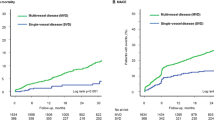Summary
Background
The recanalization success rate of chronic total occlusion (CTO) percutaneous coronary interventions (PCI) can be increased by the retrograde approach; however, the long-term outcome of patients undergoing retrograde procedures is unknown.
Aim
We aimed to evaluate the long-term major adverse cardiac and cerebrovascular event (MACCE) rate (e.g. death, myocardial infarction, coronary artery bypass surgery and stroke) in patients after retrograde versus antegrade CTO-PCI.
Methods and results
In a prospective single center study from January 2008 to June 2012, 396 consecutive patients with CTO (≥3 months old) were enrolled. The mean age was 63.4 ± 10.3 years and 86.4% were male. The success rate of the total patient cohort was 88.6%. The retrograde PCI, only attempted after a failed antegrade intervention, was performed in 18% (n = 71) of patients. Long-term MACCE rate (mean follow up 2.3 ± 1.6 years) was significantly higher in the unsuccessful compared to the successful CTO-PCI group (23.1% versus 9.4%, p = 0.01) and this was also the case in the subgroup of antegrade CTO-PCI. In the retrograde subgroup, however, procedural success had no impact on outcome. Patients with unsuccessful retrograde CTO-PCI had a significantly better collateral connection compared to patients with an unsuccessful antegrade approach. Independent predictors for MACCE were peripheral artery disease and an ejection fraction ≤30%.
Conclusion
The long-term MACCE rate after unsuccessful recanalization was significantly higher, which was driven by a higher MACCE rate after unsuccessful versus successful antegrade approaches. In contrast, procedural success in the retrograde group had no impact on outcome.


Similar content being viewed by others
References
Grantham JA, Jones PG, Cannon L, Spertus JA. Quantifying the early health status benefits of successful chronic total occlusion recanalization: results from the Flowcardia’s Approach to Chronic Total Occlusion Recanalization (FACTOR) trial. Circ Cardiovasc Qual Outcomes. 2010;3:284–90.
Hoye A, van Domburg RT, Sonnenschein K, Serruys PW. Percutaneous coronary intervention for chronic total occlusions: the Thoraxcenter experience 1992–2002. Eur Heart J. 2005;26:2630–6.
Suero JA, Marso SP, Jones PG, et al. Procedural outcomes and long-term survival among patients undergoing percutaneous coronary intervention of a chronic total occlusion in native coronary arteries: a 20-year experience. J Am Coll Cardiol. 2001;38:409–14.
Joyal D, Afilalo J, Rinfret S. Effectiveness of recanalization of chronic total occlusions: a systematic review and meta-analysis. Am Heart J. 2010;160:179–87.
Mehran R, Claessen BE, Godino C, et al. Multinational chronic total occlusion registry. Long-term outcome of percutaneous coronary intervention for chronic total occlusions. JACC Cardiovasc Interv. 2011;4:952–61.
Jones DA, Weerackody R, Rathod K, et al. Successful recanalization of chronic total occlusions is associated with improved long-term survival. JACC Cardiovasc Interv. 2012;5:380–8.
COURAGE Investigators, Shaw LJ, Berman DS, Maron DJ, et al. Optimal medical therapy with or without percutaneous coronary intervention to reduce ischemic burden: results from the Clinical Outcomes Utilizing Revascularization and Aggressive Drug Evaluation (COURAGE) trial nuclear substudy. Circulation. 2008;117:1283–91.
Nombela-Franco L, Mitroi CD, Fernández-Lozano I, et al. Ventricular arrhythmias among implantable cardioverter-defibrillator recipients for primary prevention: impact of chronic total coronary occlusion (VACTO Primary Study). Circ Arrhythm Electrophysiol. 2012;5:147–54.
Kirschbaum SW, Baks T, van den Ent M, et al. Evaluation of left ventricular function three years after percutaneous recanalization of chronic total coronary occlusions. Am J Cardiol. 2008;101:179–85.
Claessen BE, van der Schaaf RJ, Verouden NJ, et al. Evaluation of the effect of a concurrent chronic total occlusion on long-term mortality and left ventricular function in patients after primary percutaneous coronary intervention. JACC Cardiovasc Interv. 2009;2:1128–34.
Joyal D, Afilalo J, Rinfret S. Effectiveness of recanalization of chronic total occlusions: a systematic review and meta-analysis. Am Heart J. 2010;160:179–87.
Surmely JF, Katoh O, Tsuchikane E, Nasu K, Suzuki T. Coronary septal collaterals as an access for the retrograde approach in the percutaneous treatment of coronary chronic total occlusions. Catheter Cardiovasc Interv. 2007;69:826–823.
Godino C, Carlino M, Al-Lamee R, Colombo A. Coronary chronic total occlusion. Minerva Cardioangiol. 2010;58:41–60.
Sumitsuji S, Inoue K, Ochiai M, Tsuchikane E, Ikeno F. Fundamental wire technique and current standard strategy of percutaneous intervention for chronic total occlusion with histopathological insights. JACC Cardiovasc Interv. 2011;4:941–51.
Michael TT, Karmpaliotis D, Brilakis ES, et al. Procedural outcomes of revascularization of chronic total occlusion of native coronary arteries (from a multicenter United States registry). Am J Cardiol. 2013;112:488–92.
Morino Y, Kimura T, Hayashi Y, et al. In-hospital outcomes of contemporary percutaneous coronary intervention in patients with chronic total occlusion insights from the J‑CTO Registry (Multicenter CTO Registry in Japan). JACC Cardiovasc Interv. 2010;2:143–51.
Werner GS, Ferrari M, Heinke S, et al. Angiographic assessment of collateral connections in comparison with invasively determined collateral function in chronic coronary occlusions. Circulation. 2003;15:1972–7.
Joint ESC/ACCF/AHA/WHF Task Force for Universal Definition of Myocardial Infarction, Writing Group on the Joint ESC/ACCF/AHA/WHF Task Force for the Universal Definition of Myocardial Infarction, ESC Committee for Practice Guidelines (CPG), Thygesen K, Alpert JS, Jaffe AS, et al. Third universal definition of myocardial infarction. Eur Heart J. 2012;33:2551–67.
Khan MF, Wendel CS, Thai HM, Movahed MR. Effects of percutaneous revascularization of chronic total occlusions on clinical outcomes: a meta-analysis comparing successful versus failed percutaneous intervention for chronic total occlusion. Catheter Cardiovasc Interv. 2013;82:95–107.
Galassi AR, Tomasello SD, Costanzo L, et al. Long-term clinical and angiographic results of Sirolimus-Eluting Stent in Complex Coronary Chronic Total Occlusion Revascularization: the SECTOR registry. J Interv Cardiol. 2011;24:426–36.
Acknowledgements
The authors thank Anne Hartmuth for data collection.
Author information
Authors and Affiliations
Corresponding author
Ethics declarations
Conflict of interest
K. Bijuklic, C. Schwencke, and J. Schofer declare that they have no competing interests.
Rights and permissions
About this article
Cite this article
Bijuklic, K., Schwencke, C. & Schofer, J. Long-term major adverse cardiac and cerebrovascular events (MACCE) rate. Wien Klin Wochenschr 129, 243–250 (2017). https://doi.org/10.1007/s00508-016-1148-9
Received:
Accepted:
Published:
Issue Date:
DOI: https://doi.org/10.1007/s00508-016-1148-9




